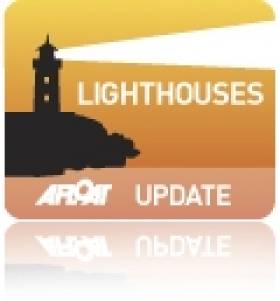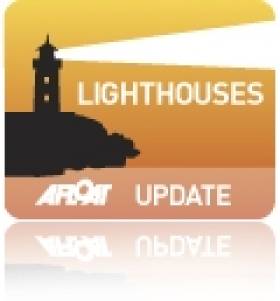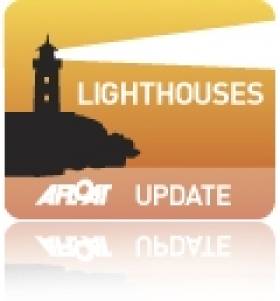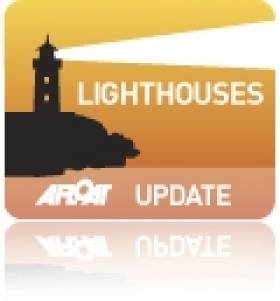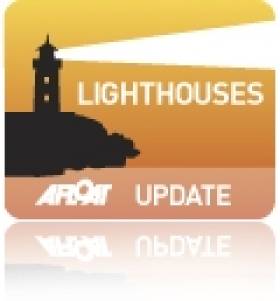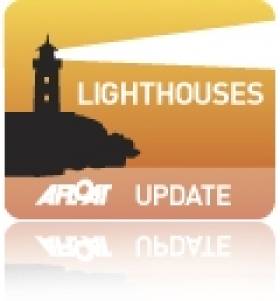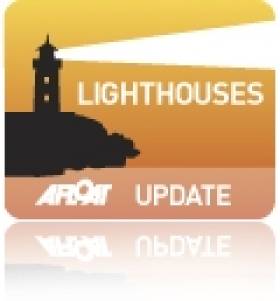Displaying items by tag: Commissioners of Irish Lights
Irish Lights Ready for Marine Emergencies, Helicopter EC135 Available for Offshore Stations
#lighthouses – As we face into a period of stormy weather over the Christmas period Commissioners of Irish Lights (CIL) stands ready to respond to any marine emergency in Irish Waters. CIL is responsible for the maintenance of physical and electronic Aids to Navigation around the Irish Coast and for ensuring safe navigation of passenger and cargo traffic in the event of wreck or other new dangers.
CIL has provided AtoN services in Ireland for over 200 years. The time of the lightkeeper has now passed as automation came to the fore in 1996 but guiding those at sea home safely during Christmas is essential in CIL's service to the mariner.
Irish and UK AtoN are monitored 24 hours a day via a sophisticated network of remote coastal communications links. This ensures that Ireland's coastal navigation network of 72 lighthouses, 29 beacons, and 118 buoys meets the international availability standard of 99.8%, giving all mariners a high degree of confidence and security for passage planning.
In the case of emergency in Irish waters, the Granuaile, CIL's 80 metre multifunctional ship with her highly experienced captain and crew of 15 will respond immediately. CIL's mechanical, electrical and electronic experts are on call 24 hours a day to cover any emergency. Lighthouse attendants around Ireland are also ready to deliver local response when required. A pilot and EC135 aircraft from Irish Helicopters is also on standby in case of emergency at offshore stations.
Modern technology now assists with the immediate response to any incident at sea. Virtual AtoNs can be digitally placed in areas of new danger through the Automatic Identification System (AIS) which all larger vessels are now required to use. As 95% of all goods arrive in Ireland by sea CIL's service and provision of maintaining AtoNs around the Irish Coast ensures the safety and efficiency of this vital service over the holiday period.CIL is a modern Maritime Safety Organisation whose mission is to 'provide aids to navigation and allied services for the safety of persons and infrastructure at sea, while also helping protect the marine environment and supporting the marine industry and coastal communities'. While CIL can date its establishment to a 1786 Act of Parliament, the organisation has always prided itself in its innovative and efficient service delivery. Today, the organisation remains committed to the efficient, effective sustainable delivery of services as it exploits new technology and new commercial opportunities.
CIL is based in Dun Laoghaire, Co. Dublin. CIL are responsible for providing marine aids to navigation (AtoN) under the Safety of Life at Sea (SOLAS) convention.
• CIL provide and maintain over 300 general aids to navigation
• CIL manage 4,000 local aids to navigation
• CIL mark or remove dangerous wrecks outside harbour areas around Ireland
CIL AtoN include radio aids such as Differential GPS (DGPS), Radar Beacons (Racon), and Automatic Identification Systems (AIS), as well as traditional visual aids such as lighthouses, buoys and beacons. These AtoN complement Global Navigation Satellite Systems (GNSS), such as GPS, which are the primary means of navigation for most mariners. If satellites are not available, these AtoN provide position, spatial awareness, hazard marking and backup.
Please visit www.cil.ie for further information.
Modification Work for Irish Lights Aids to Navigation Vessel
#LighthouseTender – The Commissioners of Irish Lights ILV Granuaile (2000/2,625grt) an aids to navigation tender vessel, is undergoing steel modification works while berthed in Dublin Port, writes Jehan Ashmore.
Work on the 79m long tender which is moored at Sir John Rogersons' Quay close to the East-Link Bridge, is been carried out by Arklow Marine Services.
The work involves fabricating of a new radar mast, installation of calorifier units and modifications to the bridge.
Steel work modifications entail fitting under deck strengthening in way of ROV pads which are to be in accordance and to the approval of Lloyds.
Killybeg based Barry Electronics are supplying and fitting a new radar which requires a new mast with existing steelwork and platform being removed.
The new calorifier unit which is to replace existing plant will be piped in using 316 stainless steel pipe materials. It is expected the quayside work be completed by the middle of this month.
ILV Granuaile is the third tender to carry the name of the famous Mayo pirate Queen.
She was built by the Damen Shipyards Group, where the hull and superstructure were completed in Romania in Galati, the largest port town on the River Danube.
Following launching, she was towed through the Black Sea to the Netherlands for fitting out at another Damen shipyard, where work included the installation of electronic equipment.
Lighthouse Tender Carries Out Replenishment at Sea with Naval Service
#JOINT EXERCISE – A replenishment at sea exercise (RAS) was carried out between the ILV Granuaile of the Commissioners of Irish Lights and the Naval Service CPV L.É. Ciara (P42) earlier this week.
The exercise is part of ongoing cooperation between CIL and the Naval Service for the purposes of demonstrating the aids to navigation tender capability in providing RAS operations to the naval fleet. Such operations would allow extending their potential endurance and operational flexibility much further offshore.
During the exercise three tonnes of freshwater was delivered in 15 minutes (12 tonnes per hour) but fuel and cargo may also be transferred.
Cork Dockyard Carries Out Docking Survey of Lighthouse Tender
#DOCKING SURVEY– The Commissioners of Irish Lights aids to navigation tender ILV Granuaile (2000/2,625grt) is currently at Cork Dockyard Ltd undergoing her scheduled docking survey, writes Jehan Ashmore.
The tender built in Romania over a decade ago and fitted out in the Netherlands by the Damen Shipyard Group, is required under regulation to drydock twice in five-yearly cycles. Her last docking was in 2009 and the the bouy-laying vessel is due her next scheduled docking in 2014.
Such docking is required by Classification Societies to inspect the underwater areas including hull, propellers, rudders, engine cooling systems, anchors, cables and anti corrosion systems.
At the same time the opportunity is taken to remove marine growth and to apply antifouling paint coatings to the underwater areas and to prepare and paint the ships hull. The principle dimensions of the hull are 79m long on a beam of 15m and with a shallow draft of 4.4m.
She has accommodation for an extra 10 persons or can accept modular housing on the after-deck where navigational aids (bouys) are stowed in cradles. Heavy lifting equipment including a 20 tonne crane with an outreach of 20m is used to position the bouys at pinpoint accuracy using satellite technology. There are 150 offshore buoys which warn mariners of the location of sand banks, reefs, and other offshore hazards near shipping routes.
A helicopter landing deck over the bow is used to transfer maintenance personnel and equipment to certain lighthouses.
ILV Granuaile's homeport is Dun Loaghaire Harbour, where she is seen frequently loading and unloading buoys alongside the various piers. On occasions she enters through the marina to berth alongside the Commissioners headquarters which includes a marine workshop depot facility, though this can only be done on certain tides and for a short duration.
Asides her primary duties serving the lighthouse authority, the vessel is capable of carrying out chain work, search and rescue, salvage and recovery, oil pollution control, towing, hydrographic applications, and ROV work.
Commissioners of Irish Lights Seeks Executive Positions
#MARINE POSITIONS – The Commissioners of Irish Lights (CIL) which for over 200 years has provided and maintained a network of marine aids to navigation around the coast of Ireland, is currently seeking two executive positions. They are Director of Corporate Services and Commercial Services Manager.
CIL's mission is to promote and deliver services for the safety and protection of persons, infrastructure and interests at sea including the protection of the marine environment. The service is to offer a reliable, cost effective and efficient, high level of service and reassurance to all customers and stakeholders.
CIL has adopted a new organisational strategy 'CIL 2015 and Beyond - Charting our Future Course' which incorporates a strong commercial dimension. The services' core business is changing with the introduction of new technologies creating new opportunities.
For further details of the executive positions which are based in CIL's headquarters in Dun Laoghaire, click HERE.
Shields Leads New Era for Commissioners of Irish Lights
#LIGHTHOUSES - Making strides in renewable energy and working in harmony with the country's marine resources are top of the agenda for the Commissioners of Irish Lights (CIL) under new chief executive Yvonne Shields.
Though its main focus will remain safety at sea through its maintenance of Ireland's coastal network of lighthouses, buoys and shipping aids, Shields tells Lorna Siggins in today's Irish Times that the agency must transform in order to pay its own way - by branching out into data and information provision for fish farms and offshore wind farms, among other services.
The 'Twitter buoy' installed in Galway for the Volvo Ocean Race finale, as previously reported on Afloat.ie, is one response to the changing face of navigation, "using next generation technologies to communicate with sea goers and navigators around our coasts".
Shields' background in the Marine Institute matches her own personal interest in the economic potential of Ireland's marine sector.
“We have 10 times our land mass out there, but it only fuels 1 per cent of gross domestic product (GDP),” she says. “There’s no reason this couldn’t increase to 5 per cent and further."
Another aspect of the agency's work is co-operation with local stakeholders around the coast, such as with the RPSB on a puffin sanctuary on Rathlin Island, and a new attitude towards exploiting Ireland's lighthouse assets as tourism destinations.
The Irish Times has much more on the story HERE.
#NEW IRISH LIGHTHOUSE – The first lighthouse of a new generation to dot the Irish coastline was officially 'switched-on' at Roancarrigmore, a small island marking the eastern entrance to Castletownbere Co. Cork, writes Jehan Ashmore.
The ceremony was performed by Minister for Agriculture, Food and Marine, Simon Coveney, T.D. Constructed of stainless steel the new structure stands only 8.5m high and is sited at the foot of the original lighthouse that towers above, where there has a light since 1847 to warn shipping to the dangers of the rocky island.
The Commissioners of Irish Lights have taken an international lead in developing this new state of the art lighthouse, which beyond technical advances is also geared to make significant cost savings due to very low maintenance requirements.
In addition there will be environment benefits from the replacement of diesel generation by renewable energy and the ending of waste-water and refuse disposal.
The lighthouse has a low-voltage LED Light and provides a clearer quality of light and is far more reliable than traditional filament lamps. The new lighting system is powered using 12 x 50W solar panels to replace the masonry tower which had a 100 Volt, 1,500 Watt filament lamp and diesel generators.
The sectored light will be supplemented and monitored by Automatic Identification System (AIS) functionality which advises the mariner directly on their bridge of the status and position of the light.
AIS is a key component of the International Maritime Organisation e-Navigation project and will ensure Roancarrig is equipped to take advantage of this initiative.
In addition there are proposals to examine possible new uses for the older lighthouse which is adjoined by a former lighthouse-house keeper dwelling used by previous generations before automation took over.
Taoiseach to Open Exhibition at Loop Head Lighthouse
#LOOP HEAD LIGHTHOUSE – An Taoiseach Enda Kenny is to officially open a new exhibition at the Loop Head Lighthouse and to launch the 2012 visitor season at the west Clare tourist attraction on 18th May.
The Clare Herald also reports that the Taoiseach's grandfather, James McGinley was a former keeper at the lighthouse (still in operation) which can date its origins back to the 1670s.
Clare County Council, along with Shannon Development, Loop Head Tourism and the Commissioners of Irish Lights, conducted a successful trial scheme in 2011 that resulted in an estimated 17,000 people visiting the landmark building. This year's season will see the visitor attraction open to the public from 19th May.
In addition the Irish Landmark Trust rents out a five-bed former lighthouse-keepers house. The property stands in the grounds of the navigation landmark located at the mouth of the Shannon Estuary.
Arklow Newbuild’s Link to Former Irish Lights Tender
#FORMER IRISH LIGHTS TENDER -With the Guardian 8 preparing to set sail from her builders homeport of Arklow this month, as previously reported on Afloat.ie, her owners Gardline Marine Services also operate a former Commissioners of Irish Lights tender, writes Jehan Ashmore.
The Great Yarmouth based company operate a multi-purpose fleet which includes the survey vessel Ocean Seeker (PHOTO). She was a familiar sight as the ILV Granuaile (1970/1,943grt) while serving for three decades from the Irish Lights marine depot in Dun Laoghaire Harbour.
Built by Fergusan Brothers of Port Glasgow, she was the last traditional tender for CIL in that her working deck was positioned forward. Apart from the short career of the Gray Seal, the 2000 built successor ILV Granuaile (the third to carry the name of the Mayo pirate queen) was the first custom built tender for CIL to introduce a radical design with an aft end work deck.
Loop Head Lighthouse Will Open To Public in 2012
#LIGHTHOUSES - Loop Head Lighthouse in Co Clare, is set to re-open to the public later this year following a successful trial scheme last summer.
As The Irish Times reports, Clare County Council opened the lighthouse for an 11-week trial period last July with the support of the Commissioners of Irish Lights, Shannon Development and Loop Head Tourism.
Some 17,000 people took up the invitation to visit the 23-metre beacon, which is still in use as a navigational aid, as previously reported on Afloat.ie.
The consortium is now looking for consultants to help expand tourism the facility with an exhibition and interpretation plan.




























